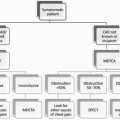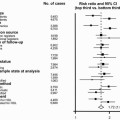Trans Fatty Acids, Dyslipidemia, and Cardiovascular Disease
Edmond K. Kabagambe
Frank A. Franklin
Trans fatty acids are unsaturated fatty acids in which the hydrogen molecules at one or more of the double bonds occur in opposite directions making the molecule assume a straight configuration, in contrast to the kinked shape in fatty acids with both hydrogen atoms on the same side of the molecule (1). The straight and kinked structures, referred to as trans- and cis-configurations, respectively, are responsible for the differences in physical and biochemical properties between trans- and cis-unsaturated fats. Increased intake of trans fatty acids is associated with a number of adverse health outcomes, including dyslipidemia, inflammation, endothelial dysfunction, and increased risk for cardiovascular disease (CVD), among other effects (1,2,3,4). For instance, daily consumption of 5 g of trans fats, an amount easily obtained from one fast food meal, lowers high-density lipoprotein cholesterol (HDL-C), raises low-density lipoprotein cholesterol (LDL-C), and is estimated to increase the risk of myocardial infarction by about 25% (3).
Unlike ruminants, humans do not synthesize trans fatty acids in their bodies. The majority of trans fatty acids (>80%) in the human diet are a result of artificial partial hydrogenation of vegetable oils, in an attempt to increase the shelf life and preserve the flavor and texture of foods. A very small amount of trans fat in the human diet comes from foods from ruminant sources such as beef, lamb, and goat meat (5). Trans fats from ruminants are referred to as natural trans fats (mainly 18:1 trans) and are a result of bacterial hydrogenation of unsaturated fatty acids in the rumen. The main trans fat isomers in the human diet are 18:1 and 18:2 trans fatty acids. In 1995 it was estimated that the amount of trans fat in the U.S. diet ranged from 2% to 4% of total energy or about 4% to 12% of total fat (6). For the survey period 1994 to 1996, the U.S. Food and Drug Administration (FDA) estimated that the average daily intake of trans fat was 5.8 g (or 2.6% of energy) and that the intakes were higher for men (6.9 g) compared to women (4.8 g) age 20 years or older (7). This amount has been decreasing and will continue to decrease due to the U.S. government requirement to declare trans fat content in foods sold in the United States (8) and to the city and/or state laws banning use of trans fat in restaurant foods, for example, in New York City and California. This approach is expected to reduce coronary artery disease cases by 600 to 1,200 cases per year within 3 years of its implementation in January 2006.
Globally, the amount of individual trans isomers and total trans fat content of foods varies considerably by region, mainly because of the variation in the food sources and type of food processing (3,9). Among trans isomers, even of equal molecular weight, there could be variations in their effects on disease end points such as mycocardial infarction (9) or intermediate phenotypes such as metabolic syndrome, inflammation, and lipid peroxidation (4,10), suggesting variability in their potency as well as relative amounts consumed. These varying effects are not surprising given the differences in physical and biochemical properties between cis- and trans-unsaturated fatty acids. It is unclear whether ruminant-derived trans fatty acids differ from industrially derived trans fats with regard to their effect on lipids, inflammation, or CVD, and current data are insufficient to conclusively make this distinction. A few studies suggest that there could be some differences in effects or potency between ruminant and industrially derived trans fats. For example, in a recent controlled study, vaccenic acid, a ruminant-derived trans fatty acid, was significantly associated with lower total cholesterol (TC) compared to a test fat rich in saturated fat (11) but vaccenic acid was not associated with blood pressure or arterial elasticity (12).
On a gram per gram basis, the effects of trans fatty acids are similar to those of saturated fatty acids except that trans fatty acids tend to be more potent in their effects, for example, on most lipids, inflammation, and CVD (13). For instance, if 10% of energy from saturated fat is replaced with 10% energy from trans fatty acids, HDL-C decreases by 15% and the TC to HDL-C ratio increases by about 13% (14). The LDL-C-raising effect of trans fatty acids has been demonstrated in most well-controlled feeding studies but this observation has not been consistent across all studies. Furthermore, the effect of trans fat on CVDs is either absent or not detectable when intakes of trans fat are low (15,16). Although many states or cities in the United States and a number of countries (e.g., Denmark) have banned, or are considering outlawing, inclusion of industrially derived trans fatty acids in the food chain (1,3), there are a number of challenges and scientific questions that remain unresolved. For instance, is there a threshold at which trans fatty acids exert their effects? To what extent does trans fat affect distribution of different lipoprotein subclasses with regard to particle number and sizes? Are trans fatty acids from ruminant sources different from industrially derived trans fats with regard to disease risk? Since trans fatty acids can cross the placenta, do they cause long-term effects to the fetus (fetal programming), or do they exacerbate the potential metabolic complications in pregnancy? Do trans fats accumulate in breast milk, and if so, what is the effect on the infants and children in the short and long term? What are the mechanisms underlying the observed effects of trans fats on inflammation,
dyslipidemia, and CVD risk? In this chapter we summarize literature on trans fatty acids with a focus on dyslipidemia and CVD. We review data on theoretical aspects of trans fats and comment on findings from the major studies on trans fatty acids, dyslipidemia, and CVD. This review is not exhaustive but intended to point the reader to the major facets in knowledge about trans fatty acids.
dyslipidemia, and CVD risk? In this chapter we summarize literature on trans fatty acids with a focus on dyslipidemia and CVD. We review data on theoretical aspects of trans fats and comment on findings from the major studies on trans fatty acids, dyslipidemia, and CVD. This review is not exhaustive but intended to point the reader to the major facets in knowledge about trans fatty acids.
THEORETICAL CONSIDERATIONS
Biochemistry
The physical and biochemical properties of trans fatty acids are intermediate between those of saturated fatty acids and cis-unsaturated fatty acids (6,17). The double bond in trans fatty acids is less reactive compared to the double bond in cis-unsaturated fatty acids of comparable chain length (6). Although theoretically trans fats are considered less prone to peroxidation, in a clinical trial in obese men, cis-9,trans-11 conjugated linoleic acid (CLA) has been shown to cause lipid peroxidation, insulin resistance, and production of inflammatory prostanglins (e.g., 8-iso-prostaglandin F2α and 15-keto-dihydro-prostaglandin F2α, which reduce noradrenaline release in the stomach and contribute to airway inflammation among other physiologic and pathologic effects) (18). Similar effects have been observed for trans-9, cis-10 CLA (18). Other trans fatty acids have also been associated with an increase in inflammation (2). For instance, several trans fatty acid isomers in the 18:1 and 18:2 configuration occur in high amounts in the human diets and are associated with an increase in circulating concentrations of lipoprotein a (Lp(a)), soluble tumor necrosis factor alpha receptors, high-sensitivity C-reactive protein (hsCRP), and markers of endothelial function such as vascular cell adhesion molecule-1 (VCAM-1), intercellular adhesion molecule-1 (ICAM-1), and E-selectin (1,2,19). An increase in inflammation due to trans fats could in part explain the observed dyslipidemia associated with consumption of trans fats. Although specific studies linking inflammation to regulation of plasma lipids are lacking, there are a few studies that suggest elevation of inflammation may lead to downregulation of lipoprotein lipase activity (20). This inhibition together with the well-known increase in cholesteryl ester transfer protein (CETP) activity (21), elevated catabolism of apolipoprotein A-I (22), and the known increase in endogenous cholesterol synthesis (23,24) following intake of trans fatty acids may explain the observed increase in fasting lipid concentrations particularly triglycerides (TG), LDL-C, and very low density lipoprotein cholesterol (VLDL-C) and decrease in HDL-C.
Trans fatty acids are very similar to cis-unsaturated fatty acids with regard to enzymes and other metabolic pathways that regulate fat synthesis and conversion to various biochemical by-products. Limited experimental data suggest that trans fats may interfere with de novo synthesis of long-chain polyunsaturated fatty acids (PUFAs) from essential PUFAs such as linoleic acid (25). It has been shown from studies in rats that trans fats reduce the activity of delta-5 and delta-6 desaturases, important enzymes for elongation of essential fatty acids (26). This competition between trans and cis fatty acids for the elongation enzymes and the inhibition of desaturase enzymes by trans fats could in part be a potential mechanism for the elevation of LDL-C and TG and the increased CVD risk attributed to consumption of trans fats. Trans fats, through their effect on desaturase enzymes, may decrease in vivo synthesis of very long chain fatty acids (VCFAs). This could decrease the expected benefit of VCFAs on platelet aggregation and other cardioprotective roles.
Metabolism
Trans fatty acids are rapidly absorbed by the human and animal gastrointestinal tracts and assimilated in membranes of red blood cells, adipocytes, and cells in other tissues where they affect cell membrane fluidity and functioning of membrane receptors (1,17). Whether trans fats also accumulate in lipid droplets of adipocytes is not clear. Because of the long half-life in these tissues, the concentrations of trans fats in red blood cell membranes or adipose tissue are often used as biomarkers for trans fat intake (9,27). In pregnant women, trans fatty acids cross the placenta and enter the fetal circulatory system. Whether the amount of trans fat entering the fetal circulation is proportional to the trans fat content in the maternal adipose tissue is unknown. In animal studies where good data are available, absorption rates for trans fatty acids (93%) are higher than those for saturated fats (86%) of comparable chain length (28). However, trans fat-rich diets seem to be less efficient with regard to energy utilization (28). Whether this implies trans fats are less likely to result in obesity is not known but increase in obesity due to trans fat is unexpected given the low contribution to total energy intake (about 2.6% of energy in the United States).
Mozaffarian et al. (1) and Fernandez and West (23) summarize other less well-known mechanisms of how trans fat may cause dyslipidemia and CVD. These include interaction of trans fats with cell membrane receptors (e.g., toll-like receptor) or nuclear receptors (e.g., nuclear factor kappa beta [NF-κβ], peroxisome proliferator activator receptor gamma [PPAR-γ], sterol regulator element-binding protein-1 [SREBP-1], and liver X-receptor) and cell signaling molecules to adversely affect plasma lipids, inflammation, and probably insulin resistance (29). In summary, the known effects of trans fats on dyslipidemia and CVD cannot be fully explained by the few known mechanisms (e.g., alteration of cell membrane fluidity, reduction of reverse cholesterol transport, and elevation of inflammation), suggesting that there are other unknown mechanisms through which trans fats exert their effects.
CLINICAL TRIALS
Most of the evidence on the effect of trans fatty acids on health comes from observational and animal studies. There are very few short-term intervention studies and to our knowledge no long-term randomized intervention trials on trans fats, probably because of ethical reasons. Thus, most of the evidence on the effects of trans fats on health is from noncontrolled prospective studies and case-control studies.
Stay updated, free articles. Join our Telegram channel

Full access? Get Clinical Tree








